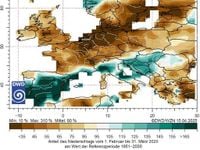Germany is facing an unprecedented drought, with experts expressing skepticism about the predictions of significant rainfall that many are eagerly anticipating. According to meteorologist Dominik Jung from wetter.net, the nation is grappling with precipitation deficits for the third consecutive month, raising concerns about the agricultural and ecological impacts of the ongoing dry conditions.
In March 2025, rainfall was approximately 70 percent below normal levels, while February recorded a deficit of 50 percent. As of mid-April, many regions have yet to see any substantial rain, leaving farmers and residents anxious for relief. "I see that currently much more cautiously," Jung stated, emphasizing the need for realistic expectations regarding the weather forecasts.
To alleviate the drought situation, Jung suggests that Germany would require widespread, steady rainfall of 100 to 150 liters per square meter over several weeks. However, he warns that such conditions are not anticipated in the coming fortnight. Instead, weather models indicate that temperatures could soar above 25 degrees Celsius by the upcoming weekend, creating summer-like conditions in April. This rise in temperature will likely exacerbate evaporation, pulling moisture back into the atmosphere even if rainfall occurs.
The predicted rain is expected to manifest mainly as localized showers and thunderstorms, which, while potentially heavy, do not replace the need for consistent rain across the landscape. Jung pointed out that isolated heavy showers are not a substitute for the prolonged, steady rain needed to properly hydrate the soil.
Despite media reports touting a "great rain," Jung cautions that the reality is more complex. Rainfall predictions, which once seemed promising, have been revised downward multiple times, indicating that a significant shift in weather patterns is still forthcoming. "Those who hope for a quick relief from the drought will likely have to be patient," he noted.
In stark contrast to Germany's dry spell, southern Europe is currently battling heavy rainfall and cold temperatures. Countries like Spain and Portugal have experienced above-average precipitation, with some areas reporting over 165 percent of their long-term average.
Adding to the gravity of the situation, the German Weather Service (DWD) has reported that the current dry spell is the most severe since records began in 1931. From February 1 to April 13, 2025, Germany saw only about 40 liters of rain per square meter, a staggering 68 percent reduction from the typical 128 liters expected during this period.
This unprecedented drought has particularly affected regions north of the Main and Mosel rivers, where precipitation levels have plummeted to less than 35 percent of normal. Southeastern Germany has fared slightly better, receiving 50 to 80 percent of the average rainfall. However, the overall picture remains bleak.
The DWD remains cautiously optimistic, forecasting that the weather may shift by mid-next week, potentially bringing significant rainfall to some areas. Until then, residents are advised to remain vigilant and prepared for continued dry conditions.
As the drought continues to unfold, the implications for agriculture, water supply, and local ecosystems become increasingly concerning. Farmers are particularly anxious about crop yields, which could be severely impacted if the dry spell persists. The uncertainty surrounding the weather forecasts leaves many in the agricultural sector on edge, hoping for a turnaround.
In summary, while there is hope for rain in the near future, experts advise that the situation remains precarious. Vigilance and preparedness are key as Germany navigates this challenging weather pattern. The coming weeks will be crucial in determining whether the drought can be alleviated or if it will continue to pose significant challenges for the nation.


